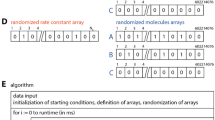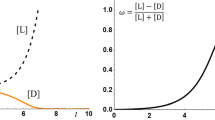Abstract
Explaining the evolution of a predominantly homochiral environment on the early Earth remains an outstanding challenge in chemistry. We explore here the mathematical features of a simple chemical model system that simulates chiral symmetry breaking and amplification towards homochirality. The model simulates the reaction of a prochiral molecule to yield enantiomers via interaction with an achiral surface. Kinetically, the reactions and rate constants are chosen so as to treat the two enantiomeric forms symmetrically. The system, however, incorporates a mechanism whereby a random event might trigger chiral symmetry breaking and the formation of a dominant enantiomer; the non-linear dynamics of the chemical system are such that small perturbations may be amplified to near homochirality. Mathematical analysis of the behavior of the chemical system is verified by both deterministic and stochastic numerical simulations. Kinetic description of the model system will facilitate exploration of experimental validation. Our model system also supports the notion that one dominant enantiomeric structure might be a template for other critical molecules.





Similar content being viewed by others
References
D.G. Blackmond, Cold Spring Harb. Perspect Biol. 2(5), a002147 (2010). doi:0.1101/cshperspect.a002147
J.D. Carroll, Chirality 21, 354–358 (2009)
M. Wu, S.I. Walker, P.G. Higgs, Astrobiology 12, 818–829 (2012)
M. Gleiser, S.I. Walker, arXiv preprint arXiv, 1202.5048 (2012)
F.C. Frank, Biochim. Biophys. Acta. 11, 459–463 (1953)
P.V. Coveney, J.B. Swadling, J.A. Wattis, H.C. Greenwell, Chem. Soc. Rev. 41, 5430–5446 (2012)
M. Klussmann, Genesis-In The Beginning 22, 491–508 (2012)
B. Barabás, J. Tóth, G. Pályi, J. Math. Chem. 48, 457–489 (2010)
D. Lavabre, J.-C. Micheau, J.R. Islas, T. Buhse, Top. Curr. Chem. 284, 67–96 (2008)
D. Hochberg, M.-P. Zorzano, Chem. Phys. Lett. 431, 185–189 (2006)
V.S. Gayathri, M. Rao, Europhys. Lett. 80, 28001 (2007). doi:10.1209/0295-5075/80/28001
D. Todorovi, I. Gutman, M. Radulovic, Chem. Phys. Lett. 372, 464–468 (2003)
M. Mauksch, S.B. Tsogoeva, Chem. Phys. Chem. 9, 2359–2371 (2008)
Y. Saito, H. Hyuga, Top. Curr. Chem. 284, 97–118 (2008)
R. Plasson, H. Bersini, A. Commeyras, Proc. Natl. Acad. Sci. USA 101, 16733–16738 (2004)
M. Gleiser, B.J. Nelson, S.I. Walker, Orig. Life Evol. Biosph. 42, 333–346 (2012)
K. Soai, T. Shibata, H. Morioka, K. Choji, Nature 378, 767–768 (1995)
M. Maioli, K. Micskei, L. Caglioti, C. Zucchi, G. Pályi, J. Math. Chem. 43(4), 1505–1515 (2008)
K. Micskei, G. Rábai, E. Gál, L. Caglioti, G. Pályi, J. Phys. Chem. B. 112, 9196–9200 (2008)
L. Caglioti, G. Pályi, Rend. Fis. Acc. Lincei. 24, 191–196 (2013)
P.C. Joshi, M.F. Aldersley, J.P. Ferris, Adv. Space Res. (2012). http://dx.doi.org/10.1016/j.asr.2012.09.036
P.C. Joshi, M.F. Aldersley, J.P. Ferris, Orig. Life Evol. Biosph. 41, 213–236 (2011)
D.K. Kondepudi, K. Asakura, Acc. Chem. Res. 34, 946–954 (2001)
C. Viedma, P. Cintas, Chem. Commun. 47, 12786–12788 (2011)
W.L. Noorduin, T. Izumi, A. Millemaggi, M. Leeman, H. Meekes, W.J.P. Van Enckevort, R.M. Kellogg, B. Kaptein, E. Vlieg, D.G. Blackmond, J. Am. Chem. Soc. 130(4), 1158–1159 (2008)
J.A. Wattis, Orig. Life Evol. Biosph. 41, 133–173 (2011)
R.H. Perry, C. Wu, M. Nefliu, R.G. Cooks, Chem. Commun. 10, 1071–1073 (2007)
S.C. Nanita, R.G. Cooks, Angew. Chem. Int. Ed. Engl. 45, 554–569 (2006)
A.L. Weber, S. Pizzarello, Proc. Natl. Acad. Sci. USA 103, 12713–12717 (2006)
A.L. Caglioti, K. Micskei, G. Pályi, Chirality 23.1, 65–68 (2011)
J.E. Hein, E. Tse, D.G. Blackmond, Nat. Chem. 3, 704–706 (2011)
J.E. Hein, D.G. Blackmond, Acc. Chem. Res. 45, 2045–54 (2012)
R. Breslow, Z.L. Cheng, Proc. Natl. Acad. Sci. USA 107, 5723–5725 (2010)
B.A. Pross, R. Pascal, Open Biol. 3, 120190 (2013)
J.C. Ianni, Kintecus, Windows Version 4.01 (2010) Available online at: http://www.kintecus.com and Kintecus Manual: http://www.kintecus.com/Kintecus_V400.pdf. Accessed 25 June 2013
J.C. Ianni, Comput. Fluid Solid Mech. 2003, 1368–1372 (2003)
W.D. Hinsberg, F.A. Houle, Chemical Kinetics Simulator, v1.01, IBM, Almaden Research Center (1996). Available online at: www.almaden.ibm.com/st/msim. Accessed 25 June 2013
S.H. Strogatz, Nonlinear Dynamics and Chaos with Applications to Physics, Chemistry and Engineering (Perseus Books, Reading, 1994)
R.F. Ludlow, S. Otto, Chem. Soc. Rev. 37, 101–108 (2008)
M. Kindermann, I. Stahl, M. Reimold, W.M. Pankau, G. von Kiedrowski, Angew. Chem. Int. Ed. Engl. 44, 6750–6755 (2005)
P.M. Schwartz, D.M. Lepore, C. Barratt, Int. J. Chem. 4, 9–15 (2012)
D.M. Lepore, C. Barratt, P.M. Schwartz, J. Math. Chem. 49, 356–370 (2011)
D.C. Osipovitch, C. Barratt, P.M. Schwartz, New J. Chem. 33, 2022–2027 (2009)
J.R. Islas, D. Lavabre, J.-M. Grevy, R.H. Lamoneda, H.R. Cabrera, J.-C. Micheau, T. Buhse, Proc. Natl Acad. Sci. USA 102, 13743–13748 (2005)
M. Mauksch, S.B. Tsogoeva, Biomimetic Org. Synth. 23, 823–845 (2011). doi:10.1002/9783527634606.ch23
M.H. Engel, S.A. Macko, Precambrian Res. 106, 35–45 (2001)
S. Pizzarello, Acc. Chem. Res. 39, 231–235 (2006)
T. Kawasaki, K. Suzuki, M. Shimizu, K. Ishikawa, K. Soai, Chirality 18, 479–482 (2006)
T. Kawasaki, K. Soai, J. Fluorine Chem. 131, 525–534 (2010)
Acknowledgments
CB and PMS gratefully acknowledge funding through the Connecticut Space Grant Consortium and the University of New Haven Faculty Research Support. BNM and JMK thank the University for supporting undergraduate summer fellowships and NASA for a CT Space Grant Fellowship (BNM).
Author information
Authors and Affiliations
Corresponding author
Rights and permissions
About this article
Cite this article
Morneau, B.N., Kubala, J.M., Barratt, C. et al. Analysis of a chemical model system leading to chiral symmetry breaking: Implications for the evolution of homochirality. J Math Chem 52, 268–282 (2014). https://doi.org/10.1007/s10910-013-0261-5
Received:
Accepted:
Published:
Issue Date:
DOI: https://doi.org/10.1007/s10910-013-0261-5




